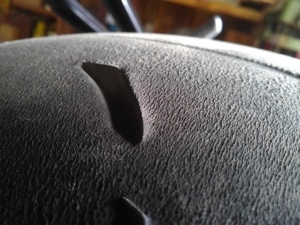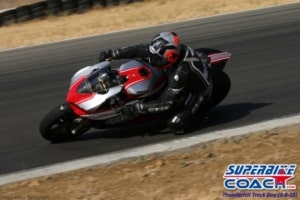Motorcycle Tire Pressure for the Track
One of the most commonly asked questions you see on the net is “what tire pressures should I run for and with the emphasis that’s put on having the correct pressures both at and away from the track it’s no wonder.
Having the right pressure for rider, bike and tire combination is very important to getting the most out of your tires both in terms of performance and longevity. As I’m sure you know tires are very expensive, so making sure we get the most out of them by having the correct pressure and therefore avoiding bad wear should be a priority for all track day riders.
The trouble is there is no one magical pressure for one type of motorcycle or type of tire, and as you’re about to find out there are times when you would even use different pressures for the same tire on the same bike!
So to help you understand what actually goes into determining the best pressure here’s a look at some of the things that affect tire pressure.
Things that Affect Tire Pressure
Weight –Someone heavier is going to create a larger contact patch on the ground which could overheat it and cause nasty wear. And vice versa, the lighter rider using the heavier rider’s pressures won’t have a contact patch big enough, so they won’t get enough heat into the tire and again you’ll see another sort of nasty wear. This problem is made worse if your suspension isn’t properly set up for your weight.
Tire Construction – Some tires have harder carcasses and sidewalls which mean they don’t need to run as high a pressure as a tire with a soft carcass.
Ambient Temperature – The outside temperature is going to affect how your tires heat up. Setting your rear to 30psi on a cold day isn’t going to give you the same performance as setting it at the same pressure on a baking hot day, because on a hot day the tire will heat up quicker and by more.
Some of the fast riders and racers actually change their pressures throughout the day to compensate for the change in temperature so they can maximize the performance of their tires.
Hot and Cold Pressures – If you set your pressure to 30psi when the tire is cold, this isn’t going to be the same as setting them to 30psi when the tire is hot. A cold tire will gain around 2-6psi (depending on your pace) through use on the track because it will heat up and so will the air inside, meaning the pressure will increase.
Road vs Track Tires – Road tires are typically designed to run at higher pressures than track tires because they are not expected to heat up as much.
As you can see, there are many factors that come into finding the best tire pressure for your bike and tire combination. Right now you may be wondering how on earth you get the right pressures, and I wouldn’t blame you, so here we go.
How can I find my best pressure?
What you want first is a good baseline pressure which you should be able to get from any of the below sources.
Manufacturer – Go direct to the manufacturer and get the pressures they recommend, you can usually find them on their website. If not, email them and ask what they would recommend setting tire ‘X’ to for use on the track. They’re usually pretty helpful with stuff like this.
Tire Expert – Speak to the tire supplier at the track, or talk to someone you know who deals with tires and setting up bikes for the track. They would have experienced many tire and bike combinations, so they know their stuff.
Other riders – See what other riders with similar setups are doing with the same tires. They too would have gone through the same process to find the best pressures for themselves, so they should be able to set you off close to where you need to be.

Once you have your base pressure, try it out and see how you get on. Did you notice any unsavory reactions from the tire that wasn’t there before? Or the more common issue, is the tire showing any signs of unnatural wear? If you answer yes to these questions then it could well be that your pressure is not quite correct.
Last Few Tire Pressure Points Worth Mentioning
When should you set your pressures? – If you have tire warmers then set them once they have been in the warmers for a good 45 minutes or so (from stone cold). If you don’t have warmers then set them cold first thing in the morning, but remember that your tires will gain a few psi so try to take that into account. Once you’ve done a couple of sessions you’ll be able to see how much psi you’re really gaining and whether or not you are near where you want to me.
Just keep an eye on the tires. If they’re showing any sort of unnatural wear then you will need to adjust your settings.
Is your pressure gauge calibrated? – You probably shrugged your shoulders at this one, but it’s not that hard to do. Just ask the tire expert at the track to set your tires to a given pressure using their compressor, then use your gauge to check it reads the pressure they just set it to. You can also check it against one or two other rider’s gauges to see if they give the same readings. If you can, change the dial to show the compensation, if you can’t (more likely) just make a note so you remember the difference.
Wet weather riding – You want to make sure you’re pressures aren’t too low for wet weather riding, be it proper race wets or road tires. If the pressure gets too low then the tread will compress which means it can’t clear water effectively.
Lastly, don’t overdo it. I know I mentioned some of the factors that come into play with getting the best tire pressure, but this was to demonstrate that there’s not a one size fits all pressure. Don’t get too hung up on trying to get the pressure perfect.
Unless you’re pushing on at the higher end of the fast group then you probably wouldn’t notice the small differences that come from things like changes in temperature throughout the day or the way you set your pressures initially. If you feel grip and you’re not showing any ugly wear patterns then that’s all you really need to worry about.
Thanks to Dan Netting for this excellent line up.











Leave a Reply
Want to join the discussion?Feel free to contribute!